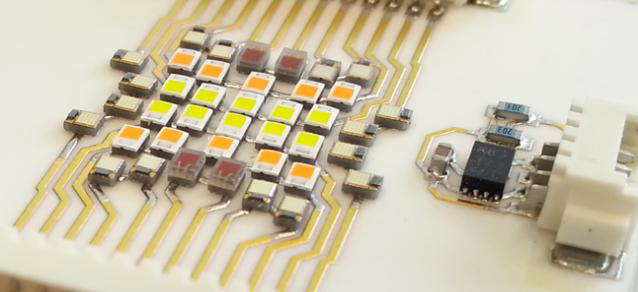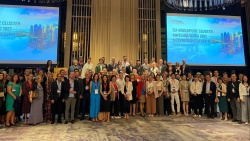One of SECPhO members, IREC is coordinating an interesting and exciting project HI-LED, that will improve and provide new innovations in lighting technologies in Artwork illumination, horticulture and greenhouses.
Scientifically, the project proposes the development of novel spectrally adjustable LED light engines with integrated intelligence, low-cost and low-consumption, sustainable according mass production requirements that are need to become a reliable system related to conventional lighting sources. With this objective in mind the project is focused on human centric lighting, art work and horticulture markets where careful selection of spectral content may achieve an optimal balance between energy efficiency and quality of light.
Photo source: Catalonia Institute For energy Research IREC, Barcelona Spain
Spectrally tunable lighting offers a new paradigm associated with the possibility to mimic any light spectrum imaginable in the visible range. Spectral optimization gives rise to a full range of potential applications where specific spectral components are critical or play an important role, while at the same time allows control over energy efficacy by adapting those components to the parts where the particular application is more sensitive to.
The HI-LED consortium is composed of recognized experts in the fields of optical lighting design, OLED manufacturing, LED lighting, neuroscience, horticulture and LED lighting manufacturers.
HUMAN CENTRIC LIGHTING
Smart engines with added intelligence offer huge possibilities, not only for energy savings but also for the functional selection of spectra that creates healthier environments, for example by following the natural illumination patterns that respect our biological circadian rhythms, or selection of particular wavelengths that stimulate a desired effect on cognitive abilities and behaviors, for example sustained concentration or working memory, and on emotional states and other neuropsychological attributes. This can be done very accurately though smart driving of LED/OLED channels, while satisfying different constraints on energy efficiency.
Our aim is to develop adaptable light sources which respond dynamically to the user’s behavioral needs. We are therefore developing an integrated system which enables study the human behavioral and perceptual responses and allow us to control the spectra in an automatic and precisely timed way. The ultimate goal of this topic is to understand the behavioral and physiological effects of different light spectra over controlled periods of time. We will develop different interfaces to take behavioral data from users, along with physiological data from wearable devices and real-time measurements of the light spectra being delivered, to determine the causal relationship between manipulations of light spectra and human responses.
HORTICULTURE & GREENHOUSES
Unlike humans, plants respond more to blue and red colors. Thus, the HI-LED module for horticulture will reproduce different parts of the visible light spectrum, and some wavelengths just outside of PAR that are readily perceived by plants, resulting in changes in plant morphology and physiology. This process of photo morphogenesis will determine the plant architecture, flower color and complex processes like flowering.
Hardware implementation oriented for horticulture research will be designed to study the process of photosynthesis (assimilation light or supplemental light) as well as for photomorphogenesis related to effects of light on plant development and cellular metabolism (light quality or steering light). Both light requirements need be defined in the horticulture module and involve the identification of wavelengths which will be used to stimulate grown and control photosynthesis and photomorphogenesis.
For the horticulture LED light module our target will be tomato crop that have a large photosynthetic capacity. In addition, tomatoes are able to utilize high light intensities or a long light duration. Like horticultural crops, these plants require relatively high levels of assimilation light and also they require an ‘average sunlight’ spectrum of photosynthetically active radiation (PAR) light so that the crop growth and development takes place according to the grower desires.
ART WORK ILLUMINATION
One of the objectives of the HI-LED project is to develop a LED engine for museum environments. This topic involves an appropriate selection of LEDs to be included into the fixture and optimize spectral power distribution according lighting requirements for museums taking into account paintings from different European art epoch.
For artwork illumination, spectral content offers optimal balance between energy efficiency, quality of light and art conservation. The main focus points are the possibility to create arbitrary lighting spectra and providing a homogeneous illumination free of luminance and chromatic variations within the final output beam. Both an LED-only and OLED module will be constructed. The large-area, low-luminance OLED device is an ideal performer in applications that need relatively low illuminance levels, low glare and an artifact free beam profile.
To achieve a spectrally optimal light source composition we need to investigate the spectral characteristics of the objects to be illuminated. This involves mainly the spectral reflection measurements of test samples from different art periods.




